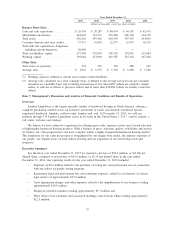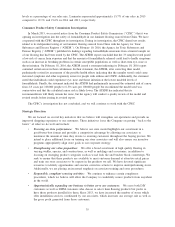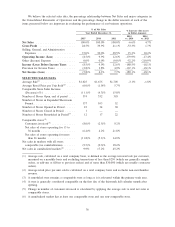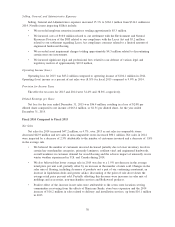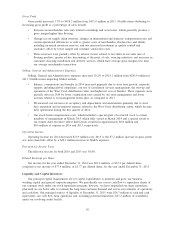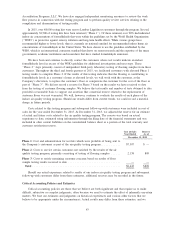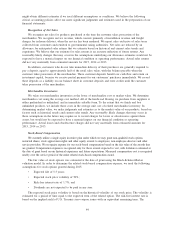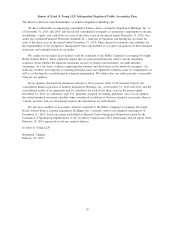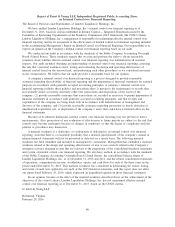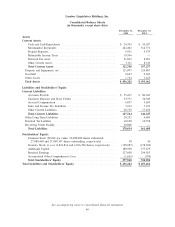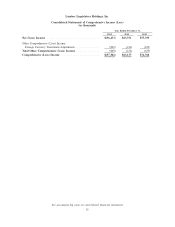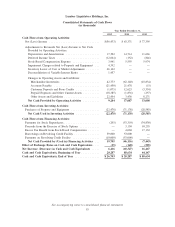Lumber Liquidators 2015 Annual Report Download - page 53
Download and view the complete annual report
Please find page 53 of the 2015 Lumber Liquidators annual report below. You can navigate through the pages in the report by either clicking on the pages listed below, or by using the keyword search tool below to find specific information within the annual report.
Accreditation Programs, LLC. We have also engaged independent monitoring resources to review the work
flow process in connection with the testing program and to perform quality review services relating to the
compilation and dissemination of testing results.
In 2015, over 48,000 testing kits were sent to Lumber Liquidators customers through the program. In total,
approximately 30,500 of testing kits have been returned (‘‘Phase 1’’). Of those returned, over 90% had indicated
indoor air concentrations of formaldehyde that were within the guidelines set by the World Health Organization
(‘‘WHO’’) as protective against sensory irritation and long-term health effects. While various groups have
recommended higher or lower levels, there is currently no national standard for recommended indoor home air
concentrations of formaldehyde in the United States. We have chosen to use the guideline established by the
WHO, which is an international consensus standard that draws on recent research and the expertise of the many
governments, academic institutions and researchers that have studied formaldehyde emissions.
We have been and continue to directly contact the customers whose test results indicate an indoor
formaldehyde level in excess of the WHO guideline for additional investigation and next steps. These
‘‘Phase 2’’ steps primarily consist of independent third-party laboratory testing of flooring samples from these
customers. Throughout the third and fourth quarters of 2015, we facilitated customers with elevated Phase 1
testing results to complete Phase 2. If the results of this testing indicates that the flooring is contributing to
formaldehyde levels in a customer’s home at elevated levels, we will work with the customer, at the
Company’s discretion, to replace the customer’s floor or compensate the customer for the cost of the floor as
part of ‘‘Phase 3’’. We did not record a reserve for Phase 3 based on the results we have received to date
from the testing of customer flooring samples. We believe the test results and number of tests obtained to date
provided a reasonable basis to support our assertion that a material reserve related to the replacement of
customer floors was not warranted. We will, however, continue to evaluate the results of each phase of the
indoor air quality testing program. Should our results differ from current trends, we could record a material
charge in future periods.
Costs related to this testing program and subsequent follow-up with customers were included in cost of
sales for the year ended December 31, 2015. At December 31, 2015, we adjusted the reserve for an estimate
of actual and future costs related to the air quality testing program. The reserve was based on actual
experience to date, estimated using information through the filing date of the financial statements and was
included in other current liabilities on the consolidated balance sheet as a portion of the total warranty and
customer satisfaction reserve.
Cost of Sales
Year Ended
Reserve
As of
December 31, 2015
Phase 1: Cost and administration for test kits which were probable of being sent to
the Company’s customers as part of the air quality testing program............ $7,307 $ —
Phase 2: Costs to service certain customers not satisfied by the results of the air
quality testing program, primarily consisting of testing of flooring samples ...... 2,138 809
Phase 3: Costs to satisfy remaining customer concerns based on results of floor
sample testing results received to date ............................... — —
Total .................................................... $9,445 $809
Should our actual experience related to results of our indoor air quality testing program and subsequent
follow-up with customers differ from these estimates, additional reserves may be recorded in the future.
Critical Accounting Policies and Estimates
Critical accounting policies are those that we believe are both significant and that require us to make
difficult, subjective or complex judgments, often because we need to estimate the effect of inherently uncertain
matters. We base our estimates and judgments on historical experiences and various other factors that we
believe to be appropriate under the circumstances. Actual results may differ from these estimates, and we
43


